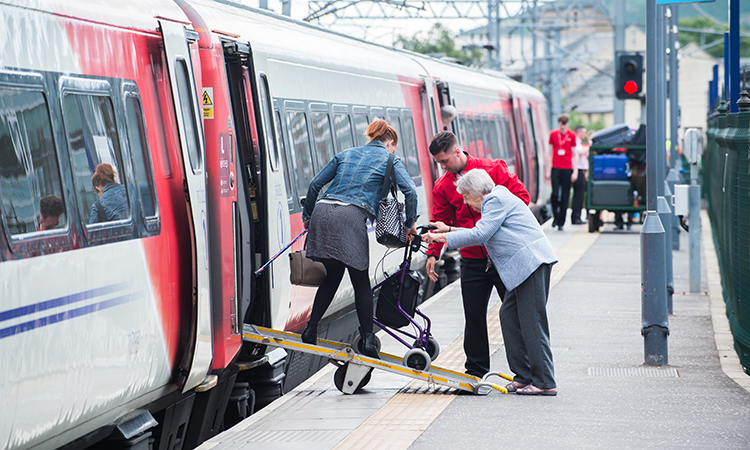Ensuring that public transport is accessible for all
- Like
- Digg
- Del
- Tumblr
- VKontakte
- Buffer
- Love This
- Odnoklassniki
- Meneame
- Blogger
- Amazon
- Yahoo Mail
- Gmail
- AOL
- Newsvine
- HackerNews
- Evernote
- MySpace
- Mail.ru
- Viadeo
- Line
- Comments
- Yummly
- SMS
- Viber
- Telegram
- Subscribe
- Skype
- Facebook Messenger
- Kakao
- LiveJournal
- Yammer
- Edgar
- Fintel
- Mix
- Instapaper
- Copy Link
Posted: 18 October 2021 | Chris Heaton-Harris - Department for Transport | No comments yet
Chris Heaton-Harris MP, the Minister of State for the Department for Transport, outlines some of the measures that the UK government is taking to ensure that the country’s transport network can be used by all.


Credit: Rail Delivery Group (RDG)/ Jack Boskett.
Accessibility across our transport network has improved vastly in recent years – a fact that I’m immensely proud of. But, of course, there’s still more to do.
Many of our iconic railway stations were built in the Victorian era and were not designed with accessibility in mind. So, we must continue to work hard to make them accessible to everyone.
That’s why I was pleased to announce the various transport elements included in the new National Disability Strategy. Through it, we will empower disabled passengers to use all forms of transport with the same confidence as everyone else – whether by train, taxi, bus or ferry.
Improving the railway
As part of the strategy, I unveiled a range of new measures to remove barriers and improve confidence for disabled people as they return to public transport after the pandemic. I’m delighted to say that we are already making progress.
An audit of all UK train stations is already well underway – helping to identify where improvements need to be made. The findings will be used for a new public database so that people can plan their journeys and, along with input from disabled passengers, will shape the future of accessible rail travel.
We are also working with Network Rail to install tactile paving at every station, adding vital safety standards for those with visual impairments. This comes on top of the development of a Passenger Assist App1 to improve communication between passengers and staff and to improve customer service.
Accessible buses and fair taxis
But, of course, our strategy is not limited to the railways. We are also bringing forward new rules to require audible and visible announcements on bus services in Great Britain, so that everyone can travel with confidence. We have boosted government grants to £3.5 million to help smaller companies to achieve this. New research into the design of bus stops and stations will ensure that they are also accessible for all.
Sticking with roads – there’s even more that we’re doing. We know that, unbelievably, some taxi drivers charge more to carry passengers with access needs. Clearly this is unacceptable, which is why we’re supporting new laws to protect disabled passengers from being exploited in this way and to ensure that they get the right help from drivers.
We have also listened to the concerns around pavement parking, which we know is another long-standing issue for those with reduced mobility. We will be publishing our plans for tackling this issue shortly.
For longer journeys, we’ve added £450,000 to the £2.2 million already invested to fund Changing Places toilets2, which provide the right facilities for the quarter of a million people who cannot use standard accessible toilets. Because everyone should be able to travel with dignity, and no one should be put off a journey because they’re worried about being able to find a suitable toilet.
We’re also looking to the future, with accessibility and inclusivity at the heart of our work on decarbonisation. Everyone should be able to play their part in helping us to reach our net zero targets, particularly as we get ever closer to COP26, with the eyes of the world on us for inspiration.
That’s why we have listened to disabled people who have told us that they could not always access electric vehicle charge points, and we’re now working with consumer groups to create more accessible designs.
The masterplan
This is all part of the UK government’s National Disability Strategy3 – the UK’s most ambitious endeavour to transform the lives of disabled people. The initiative stretches far beyond transport and includes building more supported housing, providing £300 million to improve accessibility in schools and improving access to cultural venues. It was put together with the input of more than 14,000 disabled people in one of the largest-ever exercises of its kind, and it was incredible to see policy experts, campaign groups, charities and more come together to do such important work.
One in five people currently live with a disability in the UK, and nearly all of us will have access needs at some point in our lives – whether it’s when we are elderly, pushing a pram or just carrying luggage. It is clearly essential that our brilliant transport network works for everyone, and this strategy gives us the perfect springboard to help to improve disabled people’s lives.
References
- https://passengerassistance.com
- https://www.gov.uk/government/news/changing-places-toilets-for-severely-disabled-people-to-be-compulsory-in-new-public‑buildings
- https://www.gov.uk/government/publications/national-disability‑strategy
Chris Heaton-Harris MP is the Minister of State for the Department for Transport (DfT) in the UK.
Related topics
Passenger Accessibility, Passenger Experience
Issue
Issue 3 2021
Related modes
Bus & Coach, Taxi, Train
Related cities
United Kingdom
Related organisations
Department for Transport (DfT), Network Rail, UK Government
Related people
Chris Heaton-Harris








